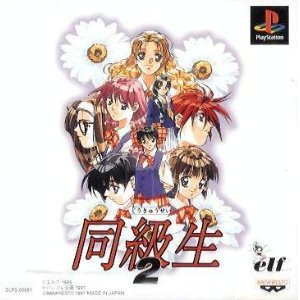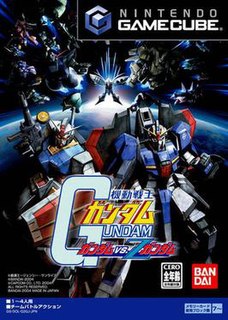 W
WAa Harimanada (ああ播磨灘) is a Japanese media franchise that began with a 1991 manga by Kei Sadayasu published in Kodansha's Weekly Morning. An anime television series was broadcast in 1992. The series was later adapted to a video game developed and published by Sega for the Sega Game Gear and Sega Mega Drive. A port was also released on the Game Boy, released by ASK.
 W
WBomberman Land is the first game of the Bomberman Land series, commemorating 15 years of the Bomberman franchise. The goal of the game is to collect 125 B-CARD pieces obtained through the adventures inside the Bomberman Land theme park.
 W
WCase Closed: The Mirapolis Investigation, known in Japan as Meitantei Conan: Tsuioku no Mirage , is a video game for the Wii. It is based upon the popular anime and manga series Case Closed by Gosho Aoyama. Players use the Wii Remote to find clues and solve the cases.
 W
WChantelise – A Tale of Two Sisters is an action role-playing game developed by EasyGameStation for Windows. It was originally released in Japan in 2006 and an English version was released on Steam and GamersGate on July 29, 2011.
 W
WCowboy Bebop is a PlayStation game published by Bandai, based on the anime of the same name.
 W
WCrayon Shin-Chan: Ora to Poi Poi is a video game for the Family Computer based on the series Crayon Shin-Chan. It was developed by TOSE and published by Bandai on August 27, 1993 in Japan only. A version of the game was simultaneously released to accommodate the Famicom's Datach Joint Rom System attachment but lacked any features that utilized the Datach's card reading capabilities.
 W
WCrayon Shin-chan: Strongest Family in Kasukabe Wii King is a videogame developed and published for the Nintendo Wii based upon the manga and anime series Crayon Shin-chan. The game was released in Spain on April 25, 2008 by 505 Games as Shin Chan: Las Nuevas Aventuras para Wii. This game was a launch title for the Wii in Japan and Spain only.
 W
WCutey Honey FX is a Cutie Honey video game developed by Datawest and released by NEC for the PC-FX in Japan in 1995.
 W
WDokyusei 2 is a video game published by ELF Corporation and the sequel to Dōkyūsei. Dōkyūsei 2 was released in 1995 for MS-DOS version and in 1997 for Microsoft Windows. A PlayStation version was released on August 7, 1997.
 W
WDragon Ball Kai: Ultimate Butōden is a fighting video game based on the manga and anime series Dragon Ball for the Nintendo DS. It was released in Japan on February 3, 2011.
 W
WOne Piece: Grand Battle! 2 is a Japan-exclusive fighting game for the PlayStation developed by Ganbarion and published by Bandai in 2002. It is the second game in the One Piece: Grand Battle! series and the seventh game to be based on the One Piece Manga and Anime. Similar to the first game, this game uses the song "We Are!" from the One Piece Anime.
 W
WGanbare Goemon: Sarawareta Ebisumaru! is a Game Boy game released in 1991 and the first game in the Goemon series ever released for a portable system. Gameplay is similar to Ganbare Goemon! Karakuri Dōchū which was released on the Famicom. Only Goemon is playable, and the game consists of him rescuing Ebisumaru; Sasuke and Yae do not make appearances.
 W
WMōryō Senki MADARA , Released in English as MADARA, is a Japanese manga series written by Eiji Ōtsuka and illustrated by Shou Tajima.
 W
WMahjong Hishō-den: Naki no Ryū is a mahjong centric Japanese manga by Junichi Nojo, which was also adapted into a three-episode OAV between 1988 and 1990.
 W
WMobile Suit Gundam: Gundam vs. Zeta Gundam is a PS2 and GameCube arcade third-person shooter. It was released on the PlayStation 2 in the U.S. on June 29, 2005, while its GameCube counterpart, which was planned for release the following month, was mysteriously cancelled. The game takes place seven years after the One Year War Gundam storyline. The game features 31 mobile suits which can be played on five different modes. These modes are arcade, versus, universal century mode, survival, and training.
 W
WMoero! Top Striker is a Japanese anime television series production based on soccer, set in the world of Italian youth football. Known in Italy as A tutto goal, despite the setting, it was not very successful in there, overshadowed by similar works such as Captain Tsubasa. It remains one of the most popular anime in France. In Japan it was aired on TV Tokyo from October 10, 1991 to September 24, 1992 and has a total of 49 episodes. In the Arab countries the anime is known as Captain Rabah, named after FC Porto striker Rabah Madjer and slightly adapted to his story as an Arab professional soccer player in Europe.
 W
WThe Oath is a shoot 'em up video game programmed by Jonathan Small with art by Sascha Jungnickel and published by Attic Entertainment Software for the Amiga in 1991.
 W
WOne Piece: Unlimited World Red is an action-adventure video game based on the famous One Piece manga and anime. This is the thirty-sixth video game based on the series, and the fifth title in the Unlimited sub-series. It was released for the Nintendo 3DS in Japan on November 21, 2013 and released for additional platforms and in more regions the following year. On March 12, 2014, the game was confirmed to be releasing in North America, Europe, and Japan in 2014 on Wii U, PlayStation 3 and PlayStation Vita. The Wii U version does not have a physical retail release in North America and Australia. Whilst other versions were released by July 8, 2014 in North America, the PlayStation Vita version was released in the region on July 14, 2014, and its limited retail release was sold exclusively via GameStop stores.
 W
WProject 575 is a multimedia project created by Sega that utilizes Vocaloid voice synthesizers in order to create traditional 5-7-5 tanka and haiku poems. It consists of an iPhone app titled Uta Yomi 575 , released on July 26, 2013, as well as a PlayStation Vita game titled Uta Kumi 575 , released on January 23, 2014 and is described as a combination of a rhythm game and a word building game. A 4-episode comedy slice of life anime television series adaptation titled Go! Go! 575 aired between January 9 and January 30, 2014.
 W
WSD Gundam: Scad Hammers is a Gundam title for the Wii in which players control a mech unit equipped with a giant hammer. It has been released in Japan. The game is illustrated by Kunio Okawara.
 W
WTakeru: Letter of the Law is a video game based on the manga series by Buichi Terasawa. It was originally released by Matsushita Electric Industrial for the 3DO Interactive Multiplayer only in Japan as Terasawa Takeichi no Takeru (寺沢武一の武), before being converted to the Microsoft Windows and Mac OS computer systems and published internationally Takeru: Letter of the Law and Buichi Terasawa's Takeru in 1996. The manga was opublished in English in 1992-1993 as Takeru - The Bad Boy of Yamato.
 W
WToki no Tabibito: Time Stranger is an animated film based on the novel by Taku Mayumura. Made by Madhouse Studios and directed by Mori Masaki, the film was released in Japan on December 20, 1986 on Kadokawa Shoten and Toho. The character designs were by Moto Hagio.